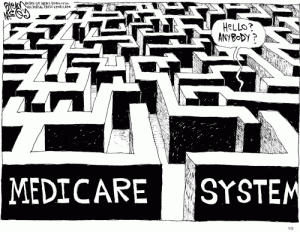In July of 2012, “The Future of Home Care Technology” was published . . . a lot has happened since then.
By Laurie Orlov
Imagine the coordinated care scenario that includes . . .
Home Care.
In July of 2012, The Future of Home Care Technology was published, based on interviews with 21 industry executives and a survey of 315 home care managers (including non-medical care, home health care, geriatric care managers, organizations and franchises) who represented 34,509 workers across multiple states. And as market research reports tend to do, this one tries to predict the future use of technology. It’s worth a look back, both to re-read a much-downloaded report and place it in 2016 context of actions, announcements, and industry change.
A futuristic scenario was described – what system supports this?
An 85-year-old woman living alone, Mrs. Smith, faints outside and is taken by ambulance to the hospital. The admission staffer scans a card she carries – it accesses a Home Care Information Network (HCIN). The card reveals her health status, plus contact information for her most recent home care agency and the visit history. Her in-hospital Care Coordinator, Ann, takes charge of Mrs. Smith, and a future home care plan is initiated. While in the hospital, Ann arranges for meal delivery, supplies, and a home care post-hospitalization visit. Using the information from the HCIN, long-distance family members are invited to participate in video meetings during her stay. Once Mrs. Smith is home, responsibility for her care is smoothly transferred to the Home Care Coordinator who will continue to oversee her care, ensuring that home health services are begun, visits are scheduled, and vital signs are taken. Mrs. Smith is eventually transitioned to non-medical home care visits.
The organization names and some rules were changed.
Many changes have happened in four years. In the context of 2012, the report noted that for home care, “there is no nationwide regulation or documented expectation about what care should be offered, its standard of care, or who will monitor its quality and delivery.” Four years later, what has changed besides the names of organizations? NPDA (private duty home care) became HCAOA, NAPGCM (geriatric care managers) became the Aging Life Care Association. In 2015, the Department of Labor enacted the Home Care Final Rule, giving minimum wage and overtime protection to 2 million workers. And home health providers received approval to provide more types of care. What else?
Home care is beginning to be ‘tech-enabled’ – does it mean the future is here?
From last year’s “Hometeam announcement: Hometeam provides an iPad for each home with an app that the caregiver uses to track care and communicate with the family via texts, pictures and medical updates.” Most recently, GrandPad and ComfortKeepers announced plans to provide “tablets specifically designed for seniors to allow elderly individuals to stay connected; it also offers access to games, video chat features, and the opportunity to take part in photo sharing.” Next, will home care be connected to the health care system? Will health care providers, faced with readmission penalties, quality metrics and a growing frail population, make the Future of Home Care Technology happen?
Comments welcome!








